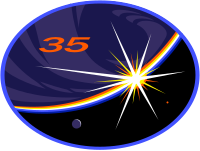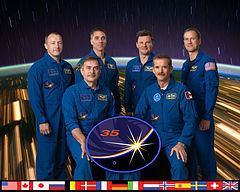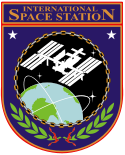Ekspedycja 35
 | |
| Pojazd | |
| Pojazd dowożący | Sojuz TMA-07M, Sojuz TMA-08M |
|---|---|
| Załoga | |
 Zdjęcie załogi, od lewej: Aleksandr Misurkin, Pawieł Winogradow, Christopher Cassidy, Roman Romanienko, Chris Hadfield, Thomas Marshburn | |
| Załoga | 6 |
| Start | |
| Miejsce startu | Kosmodrom Bajkonur, Kazachstan |
| Początek misji | 15 marca 2013, 23:42:54 UTC |
| Wyjście w przestrzeń kosmiczną | 12 h 8 min |
| Misja ISS | |
| Lądowanie | |
| Lądowanie | 13 maja 2013, 23:07:54 UTC |
| Czas trwania misji | 58 d 23 h 25 min |
| Międzynarodowa Stacja Kosmiczna | |
Ekspedycja 35 – stała załoga Międzynarodowej Stacji Kosmicznej, która sprawowała swoją misję od 15 marca do 13 maja 2013 roku. Ekspedycja 35 rozpoczęła się wraz z odłączeniem od stacji statku Sojuz TMA-06M i trwała do odcumowania od ISS statku Sojuz TMA-07M.
Załoga
Astronauci Roman Romanienko, Thomas Marshburn i Chris Hadfield przybyli na ISS 21 grudnia 2012 roku na pokładzie Sojuza TMA-07M i weszli w skład Ekspedycji 34. Po odłączeniu od stacji Sojuza TMA-06M stali się oni członkami 35. stałej załogi ISS. Początkowo znajdowali się oni na stacji jedynie w trójkę[1]. 29 marca 2013 roku dołączyli do nich Pawieł Winogradow, Christopher Cassidy i Aleksandr Misurkin, którzy przybyli na pokładzie Sojuza TMA-08M[2].
Gdy 13 maja 2013 roku Sojuz TMA-07M odłączył się od stacji z Romanienką, Marshburnem i Hadfieldem na pokładzie, zakończyła się misja Ekspedycji 35. Jednocześnie kosmonauci Winogradow, Cassidy i Misurkin przeszli w skład 36. stałej załogi ISS[3].
| Funkcja | Pierwsza część (15-29.03.2013) | Druga część (29.03-13.05.2013) |
|---|---|---|
| Dowódca | 3. lot kosmiczny | |
| Inżynier pokładowy 1 | 2. lot kosmiczny | |
| Inżynier pokładowy 2 | 2. lot kosmiczny | |
| Inżynier pokładowy 3 | 2. lot kosmiczny | |
| Inżynier pokładowy 4 | 3. lot kosmiczny | |
| Inżynier pokładowy 5 | 1. lot kosmiczny | |
Spacery kosmiczne
Podczas Ekspedycji 35 wykonano dwa spacery kosmiczne. Pierwszy z nich miał miejsce 19 kwietnia 2013 roku. Kosmonauci Pawieł Winogradow i Roman Romanienko ubrani w skafandry Orłan opuścili pokład stacji o 14:03 UTC poprzez śluzę powietrzną Pirs. Pierwszym zadaniem kosmonautów była instalacja eksperymentu Obstanowka na module Zaria, który posłuży do zbadania wpływu pogody kosmicznej na jonosferę. W czasie tego wyjścia wymieniono również retroreflektor laserowy wykorzystywany podczas dokowania statków ATV. Następnie kosmonauci zajęli się demontażem kilku innych eksperymentów wcześniej umieszczonych na zewnątrz stacji. Panel z jednym z eksperymentów wyślizgnął się Winogradowi z rąk. W efekcie nie udało się go odzyskać. Trajektoria lotu wypuszczonego panelu badawczego nie stanowiła jednak zagrożenia dla stacji ISS. Spacer kosmiczny zakończył się o 20:41 UTC po 6 godzinach i 38 minutach[4].

W drugim spacerze kosmicznym uczestniczyli astronauci Christopher Cassidy i Thomas Marshburn. 11 maja 2013 roku o 12:44 UTC opuścili oni pokład stacji przez śluzę Quest ubrani w skafandry EMU. Głównym zadaniem astronautów była wymiana urządzenia sterującego pompą na segmencie P6 struktury kratownicowej, co miało zatamować wyciek amoniaku. Po wymianie urządzenia uruchomiono pompę, a astronauci przyglądali się jej w poszukiwaniu ewentualnych wycieków. Nie stwierdzili oni jednak żadnych nieprawidłowości. Spacer kosmiczny zakończył się o 18:14 UTC po 5 godzinach i 30 minutach[5].
Galeria
Chris Hadfield podczas zabawy z jajkami wielkanocnymi w module Kibō
Załoga Ekspedycji 35 w module Unity
Zobacz też
Przypisy
- ↑ Sojuz TMA-07M, lk.astronautilus.pl [dostęp 2016-08-01].
- ↑ Sojuz TMA-08M, lk.astronautilus.pl [dostęp 2016-08-01].
- ↑ Expedition 35-36 Press Kit, www.nasa.gov [dostęp 2016-08-01].
- ↑ Spacewalkers Deploy Plasma Experiment, Install Navigational Aid, www.nasa.gov [dostęp 2016-08-01].
- ↑ Astronauts Complete Spacewalk to Repair Ammonia Leak, www.nasa.gov [dostęp 2016-08-01].
Linki zewnętrzne
Media użyte na tej stronie
The flag of Navassa Island is simply the United States flag. It does not have a "local" flag or "unofficial" flag; it is an uninhabited island. The version with a profile view was based on Flags of the World and as a fictional design has no status warranting a place on any Wiki. It was made up by a random person with no connection to the island, it has never flown on the island, and it has never received any sort of recognition or validation by any authority. The person quoted on that page has no authority to bestow a flag, "unofficial" or otherwise, on the island.
If the International Space Station were a school, this scene in the Unity node would be of the teachers' lounge. This said because it is obvious the six Expedition 35 crew members are not discussing critical issues aboard the orbital outpost. The moments are few and far between in which they share the common opportunity to "lounge" together. Expedition 35 Commander Chris Hadfield of the Canadian Space Agency is at right. Clockwise from his position are the five flight engineers -- NASA astronauts Tom Marshburn and Chris Cassidy, and Russian cosmonauts Alexander Misurkin, Roman Romanenko and Pavel Vinogradov.
Astronaut Chris Cassidy, Expedition 35 flight engineer, conducts a session of the Burning and Suppression of Solids (BASS) experiment onboard the Earth-orbiting International Space Station. Following a series of preparations, Cassidy conducted a run of the experiment, which examined the burning and extinction characteristics of a wide variety of fuel samples in microgravity and will guide strategies for extinguishing fires in microgravity. BASS results contribute to the combustion computational models used in the design of fire detection and suppression systems in microgravity and on Earth.
Chris Hadfield caption: "It appears that I'm as bad at juggling in weightlessness as I am on Earth. Hopefully I'm better at hiding them..."
Astronaut Chris Hadfield juggling with Easter eggs on board the International Space Station in March 2013.
Emblazoned with a bold 35 for the 35th expedition to the International Space Station (ISS), this patch portrays a natural moonlit view of the Earth from the ISS at the moment of sunrise, one of the sixteen that occur each day at orbital velocity, with glowing bands of Earth's atmosphere dispersing the sun's bright light into primary colors. The Earth is depicted as it often appears from space, without recognizable coastlines or boundaries - just as the international endeavor of living and working together in space blurs technical and cultural boundaries between nations. The ISS is the unseen central figure of the image, since the view is from a window of the Space Station itself, commemorating full use of the Space Station as a long-duration dwelling from which humans can develop techniques and technologies to further explore. The crew points out, "The arc of the Earth's horizon with the sun's arrows of light imply a bow shooting the imagination to Mars and the cosmos where our species may one day thrive."
Expedition 35 Russian cosmonaut Pavel Vinogradov translates outside the International Space Station on April 19, 2013, during the first spacewalk of the Expedition 35 mission. Vinogradov and fellow cosmonaut Roman Romanenko (out of frame) went on to spend about six hours upgrading the station's exterior hardware.
Russian cosmonaut Alexander Misurkin (right) and NASA astronaut Chris Cassidy, both Expedition 35 flight engineers, work in Rassvet (MRM1) on the Earth-orbiting International Space Station on April 3, 2013.
Expedition 35 inside Soyuz TMA-07M, preparing for undocking from the ISS. (l-r) Thomas Marshburn, Roman Romanenko, Chris Hadfield.
Expedition 35 crew members take a break from training at NASA's Johnson Space Center to pose for a crew portrait. Pictured on the front row are Canadian Space Agency astronaut Chris Hadfield (right), commander; and Russian cosmonaut Pavel Vinogradov, flight engineer. Pictured from the left (back row) are Russian cosmonaut Alexander Misurkin, NASA astronaut Chris Cassidy, Russian cosmonaut Roman Romanenko and NASA astronaut Tom Marshburn, all flight engineers.
Expedition 35 Flight Engineers Chris Cassidy (left) and Tom Marshburn completed a space walk at 2:14 p.m. EDT May 11 to inspect and replace a pump controller box on the International Space Station's far port truss (P6) leaking ammonia coolant. The two NASA astronauts began the 5-hour, 30-minute space walk at 8:44 a.m.



















